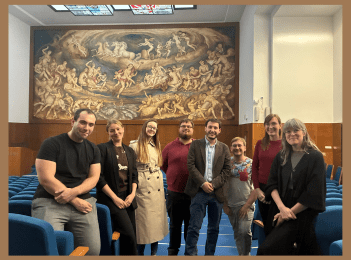From our bookshelf…
Book review
Under the heading ‘from our bookshelf’, we will regularly introduce literature that guides our thinking about our project on strategic climate litigation and the democratic process. Today, Christina Eckes introduces a book by Roda Verheyen, a German renowned environmental lawyer and pioneer in the field of climate litigation.
The German publication “Wir Alle Haben Ein Recht auf Zukunft” (We all have a right to a future) by Roda Verheyen, co-authored with Alexandra Endres, is an inspiring and profoundly impactful work that addresses one of the most pressing issues of our time—climate justice in a world increasingly suffering from the consequences of the climate crisis. An English translation in the near future would do the relevance of this book justice. Its importance reaches far beyond the borders of Germany!

Verheyen presents a unique perspective on the ever growing field of climate litigation, drawing on her own experience in spearheading some of the standard-setting cases such as the Neubauer case before the German Federal Constitutional Court, the Carvalho case before the European Court of Justice and the Lluiya case pending before German courts. Because of her experience, Verheyen provides a unique perspective of a true insider, illustrating how court cases have a role to give teeth, not only to international political commitments but also to binding international agreements.
The book stands out for its ability to blend rigorous legal analysis, background information on how legal texts (e.g., the Aarhus Convention) and judicial decisions were conceived (e.g., Lluyia vs RWE, Neubauer, Carvalho), with stories about the individual human experience of the climate crisis that led individual litigants to take their grievances to court. The personal experiences of Saúl Luciano Lluyia, a mountain guide from Peru; Sophie and Silke Backsen, a family of farmers from the German island of Pellworm; and the Sanna Vannar, a Sami woman from Sweden make the disperse and time-delayed consequences of the abstract and complex climate issue tangible, accessible, and engaging. These individual stories form together a narrative that gives meaning to the threat of the climate crisis.
At the same time, as a practicing lawyer with ties to academia, Verheyen provides a robust framework for understanding the intricacies of climate litigation, such as the great relevance of science, the watershed moment of whether a litigant manages to get into the door of the court. While drawing on her personal experiences and sharing strategic considerations, Verheyen takes a step back, places the cases, which she had brought and supported personally, in the context of other cases of strategic climate litigation. This allows her to take a broader perspective and reflect more on legal opportunity structures and the crucial differences of these structures between jurisdictions, e.g., German, the US and the Netherlands.
This aspect of the book is particularly relevant for our project because we pursue the distinct objective to unearth and explain differences in strategic climate litigation between the four national jurisdictions (DE, FR, NL, UK), including in comparison with other European national jurisdictions (e.g., CZ, ES and IT), and identify how the interaction with European Union law and the European Convention of Human Rights enhances and weakens certain legal grounds and opportunities, opens and closes access to court, and shifts responsibilities. In these jurisdictions, we trace, analyse, and compare how judges, litigants, and the media in six European jurisdictions rely on international and European legal and political commitments, as well as climate science. Both points also discussed by Verheyen in the context of the cases she presents.
The book engages with several of the critiques that have been expressed against using climate litigation to hold governments and corporations to account. These critiques include the difficulties arising from holding several actors accountable for the same emissions; concerns about the role of judges in advancing climate policy; and that companies, such as RWE, VW, Shell, should be able to trust that lawful conduct does not infringe legal principles and human rights. Verheyen takes clear positions on these criticisms and debunks them in an accessible and disarming way. She also addresses the doctrine that makes it effectively impossible for EU climate policies from being reviewed by the European Court of Justice. Verheyen encountered the illogic of the so-called Plauman-doctrine herself when spearheading the largest case to date (Carvalho/the People’s Climate Case) that brought climate litigation to the Luxembourg courts and in this book she convincingly sets out why this decade old jurisprudence is no longer fit for purpose. On several occasions, Verheyen sketches what would happen if we think the arguments of her opponents out. She presents us with the question of where this would lead in terms of the enjoyment of human rights and climate justice.
The climate cases the book describe come alive through the detailed descriptions of the very tangible impacts that the people that started these cases endure. They present the concrete and real human dimension of the climate crisis, but also illustrate on a more abstract level the growing climate impacts in Europe and beyond. The book brings the perspective of litigants home and it is difficult to imagine that the reader, after putting the book down, is able to see climate litigation with the same eyes. Legal battles on how to address the climate crisis are given faces, families, and fellow travelers. The stories not only bring alive the tragedy of disappearing livelihoods in countries such as Peru and Germany, but also the inspiring resilience and determination of individuals and communities fighting for their right to a sustainable future. For all those, reading and analysing the cases that Verheyen draws on but also strategic climate litigation more broadly, the book helps to bring colour to the often dry presentation of the legal analysis of strategic climate litigation without distracting from the power of law as a tool of change.
“Wir Alle Haben Ein Recht auf Zukunft” not only educates, but also motivates. It makes a compelling case for our collective responsibility and right to a sustainable future. Verheyen leaves the reader with a sense of urgency as well as hope. Despite the gravity of the climate crisis (or perhaps because of it), the distinctive optimistic tone leaves the reader with a sense of empowerment. The subtitle, ‘an encouragement’ (“Eine Ermutigung”) is fitting as the book indeed encourages readers to believe in the possibility of change and above all the possibility to take action towards achieving such change






